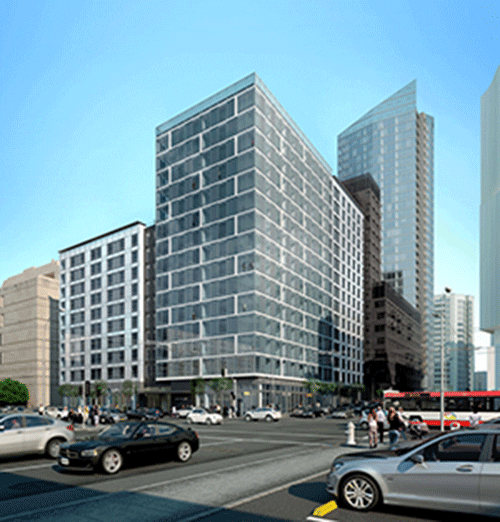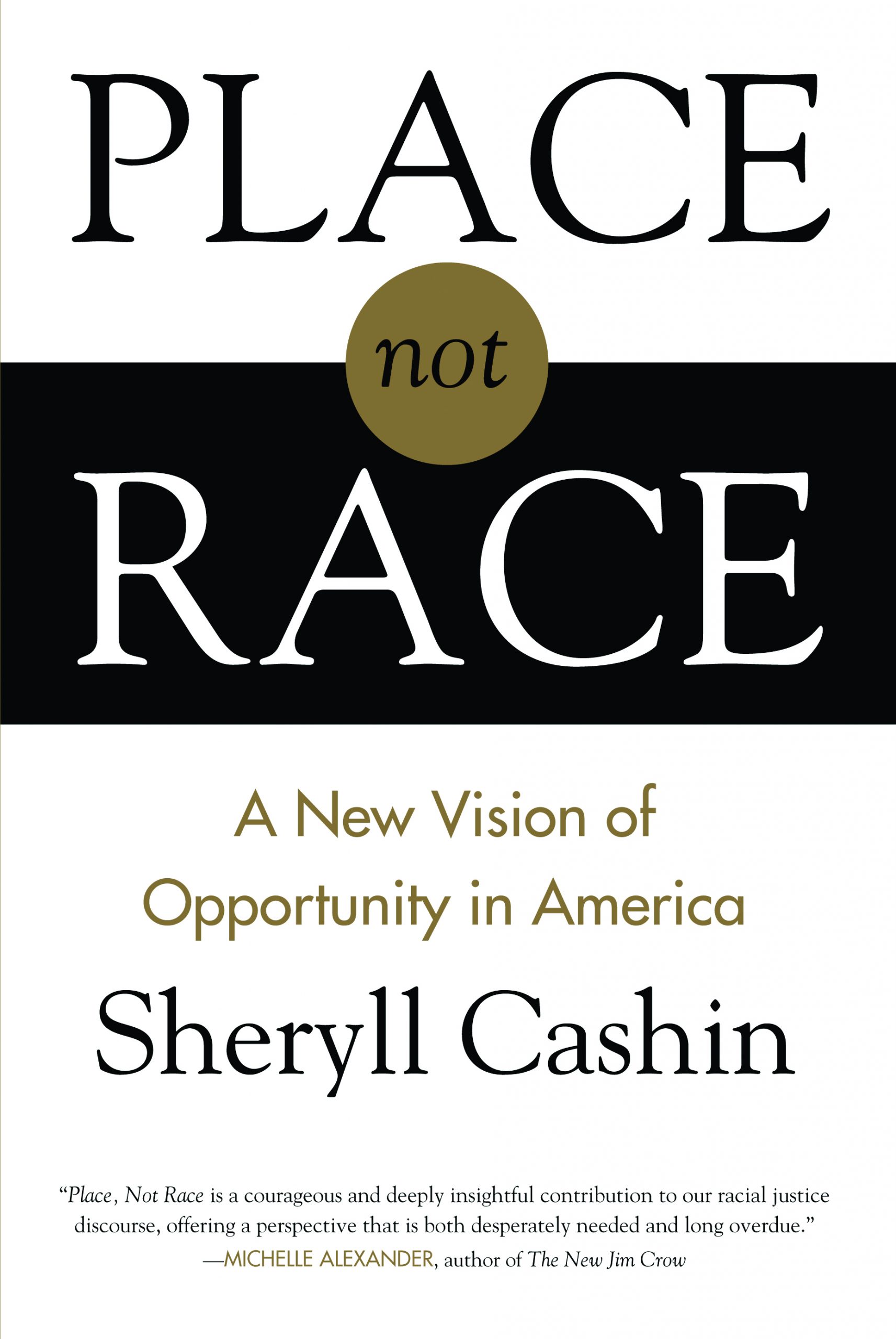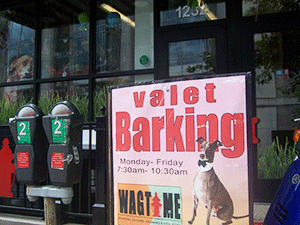
Rendering of 1400 Mission Street in San Francisco, a 100 percent below market-rate apartment building built by Tenderloin Neighborhood Development Corporation. Courtesy of TNDC
The following is an excerpt from the Lincoln Institute of Land Policy | Focus Report on Inclusionary Housing
The desire to create and sustain more mixed-income communities has been a key motivation behind many inclusionary housing programs. The evidence suggests that most inclusionary programs are able to deliver affordable housing efficiently and at the same time integrate those units into areas of economic opportunity that other affordable housing programs have difficulty reaching. At the extremes, however, communities are sometimes forced to choose between housing the greatest number of households and integrating that housing into the greatest range of environments.
Does support for this general goal of economic integration imply that we need to ensure integration into every project? To address the more extreme cases, it is important to look closely at the motivation for polices that promote economic integration, the research on the effectiveness of mixed-income housing, and the pros and cons of each approach (Table 1, above). Recent experiences in San Francisco and New York City offer insights into the challenges of meeting broad goals and expectations with a single policy.
Case Study: San Francisco
San Francisco’s Central Market neighborhood has been changing. One of the most high-profile changes has been a new, 19-story luxury apartment building called NEMA, located directly across the street from Twitter’s new headquarters. NEMA is billed by its developer as not simply upscale but “inspirational” living because of the wide range of high-end amenities, from 24/7 spa treatments to dog walking services. Like other recent developments, NEMA was required to rent 12 percent of its 750 units to low-income residents at affordable prices.To document this program, filmmaker Michael Epstein followed one of the lower-income families that moved into NEMA. After falling on hard times, the Rameriz family had been living in a van under the Golden Gate Bridge and then briefly in a homeless shelter before moving into the gleaming new NEMA tower. And yet Yesenia Rameriz describes her family’s new living situation as “awkward.” The building has no other children, but it does have a “doggie spa.” Next door to San Francisco’s NEMA apartment tower, another residential tower is being built by the nonprofit Tenderloin Neighborhood Development Corporation (TNDC). Like the affordable units at NEMA, this project also resulted from San Francisco’s inclusionary housing program. But in the TNDC project, all of the 190 apartments will be affordable to low- or moderate-income families. Where NEMA offers mostly studio and one-bedroom units, TNDC’s project has mostly two-bedroom and even some three-bedroom apartments. TNDC was able to build this project with financial support from the developer of a nearby 650-unit luxury condo project that elected to take advantage of the off-site production option under San Francisco’s inclusionary program (Conrad 2014). This off-site partnership will produce far more affordable units than the developer would have been required to provide on-site.This kind of compromise has been controversial in San Francisco, where many housing advocates are understandably concerned that developers will see the off-site option as a loophole, allowing them to provide substandard housing in undesirable locations. On-site inclusion of affordable units within market-rate projects seems to work well most of the time, and it remains the city’s preferred outcome. Most of the city’s inclusionary residents blend comfortably into market-rate projects where the cost of affordable and market-rate units are not quite so far apart. Collecting fees or creating off-site projects might be less efficient in many of these cases. But luxury projects like NEMA, where the benefits of inclusion decline as the costs increase, make it clear that on-site units may not always be the best option.
Case Study: New York
In 2009, New York City made a set of changes to its zoning rules—including one that would allow developers of inclusionary projects to concentrate their affordable units in separate buildings on the same lot. Separating the affordable units in this way was considered more economically efficient and enabled these developers to access additional tax benefits. While many cities prohibit this practice, New York’s inclusionary program is voluntary. After considering the alternative—developers opting out of the program—city leaders decided that the benefit of more voluntary units would outweigh any negative consequences.Five years later, this obscure change of policy made national headlines because of the placement of a single door on one property. Several developers had already taken advantage of the new policy without apparent controversy. But an approved development on Riverside Boulevard came under intense public scrutiny because it featured two doors—one on Riverside Boulevard for buyers of the luxury condos selling for up to $25 million, and one on 62nd Street for the tenants paying as little as $850 a month.The New York Times referred to the second door as a “poor door” and called the practice “distasteful”. A state assemblywoman said, “It looks and smells like discrimination.” Somehow, in a city that had long allowed off-site development, the idea of separating affordable residents within a site had seemed like an acceptable compromise. But the image of mixed-income buildings with two different doors touched a raw nerve with the public.
Mixed-Income, Mixed Results
Since the mid-1980s, a broad consensus among scholars and urban planners has emerged in support of the idea that housing policy should encourage the creation of more mixed-income communities. The work of William J. Wilson highlighted the serious and compounding challenges that result from overconcentration of urban poverty and suggested that social isolation of people in high-poverty neighborhoods might lead to the creation of an “underclass” that was very hard to escape. While the supposed “culture of poverty” does not appear to explain the results, there is clear evidence that even better-off residents suffer significant social and economic disadvantage when they live in neighborhoods with very high concentrations of poverty.
In one example, the Pew Charitable Trust’s Economic Mobility Project followed 5,000 families to determine whether children moved up or down the income ladder relative to their parents. Surprisingly, the study found that the poverty rate in the neighborhood where children grew up strongly predicted their economic mobility as adults even more strongly than differences in their parents’ education level or occupation (Sharkey 2009).
It is easy to see that children who live in distressed communities face tougher odds. But what we haven’t been able to prove before is whether those underprivileged neighborhoods attract families who would face challenges anywhere, or whether it is something about the places themselves that negatively affects the kids.
A new study from Harvard University (Chetty and Hendren 2015) has added very strong new evidence to support the conclusion that the places themselves matter. Economists studied children who moved from “worse” to “better” neighborhoods and found that kids who grew up in better neighborhoods earned more as adults when compared to kids who didn’t move or who moved to a worse neighborhood. And the effect grew over time. The younger kids were when they moved, the greater the gains. Similarly, the researchers found that younger siblings in families that moved experienced better economic outcomes relative to their older brothers and sisters who spent less time in the better neighborhood before entering adulthood. This research suggests that housing policies encouraging greater economic integration will lead to better economic outcomes for lower-income children.
Concentrated poverty was clearly an outcome of the housing policies of the mid-twentieth century. But by the end of the century, many housing programs explicitly began seeking to create more mixed-income communities. A range of mixed-income housing programs and policies have been studied widely, and while the results are sometimes contradictory, the evidence paints a fairly consistent picture of both the potential and the limitations of mixed-income housing.
On the positive side, lower-income residents appear to benefit socially and economically from mixed-income communities. In a series of carefully designed experiments, inner-city public housing residents were offered housing vouchers that would enable them to rent market-rate apartments for no more than they had been paying in public housing. Families that moved to neighborhoods with low poverty levels saw physical and mental health improvements and increased self-esteem and motivation. The studies also showed that those who moved to higher-income areas were more likely to be employed, although their wages were no higher than those of residents who relocated in low-income neighborhoods (Levy, McDade, and Dumlao 2011).
Many policy makers pursued mixed-income housing policies in the hope that social interactions between lower-income and higher-income residents would lead to better access to jobs or other resources for lower-income residents. The research clearly suggests that these hopes are not realistic. Explaining her opposition to “poor doors,” Manhattan Borough President Gale Brewer described her aspirations for inclusionary housing to The Wall Street Journal: “I’m hoping that as time goes on, people will share play dates, and I hope that they’ll do BBQs together.”
The Urban Institute reviewed dozens of studies of housing programs that promoted mixed-income communities and found little evidence of any meaningful social interaction between lower-income and higher-income neighbors in mixed-income developments. It also found no evidence that lower-income residents reliably benefitted from the employment connections or other “social capital” of their higher-income neighbors (Levy, McDade, and Dumlao 2011). Even among members of the same income and racial groups, this kind of social interaction among neighbors appears to be rarer than is often imagined.
Integration of lower-income residents into middle- and upper-income neighborhoods can be very valuable, but integration in the same building may offer few additional benefits.
Ensuring Access to Opportunity
This research result does not mean that on-site performance is not a key way to achieve the real benefits that economic integration does offer. Inclusionary housing programs with on-site performance requirements may be one of the very few successful strategies available for integrating lower-income housing into high-opportunity neighborhoods at all.
Recent research has shown just how hard it is to achieve economic integration through traditional affordable housing strategies. A 2012 New York University study found that the vast majority of subsidized affordable housing was located in neighborhoods with poor performing schools. The schools nearest to public housing projects had a median state test score ranking in the 19th percentile (81 percent of schools performed better). Low Income Housing Tax Credit projects did slightly better; their nearest schools ranked at the 30th percentile. But even families with portable housing choice vouchers ended up in locations where the nearest school had a median rank at the 26th percentile. For a variety of reasons, these families who should have been able to rent anywhere ended up in neighborhoods where 75 percent of kids qualified for free lunch at school (Ellen and Horn 2012). Decades after embracing “deconcentration of poverty” as a federal housing policy goal, most federal programs don’t appear to be achieving meaningful economic integration.
By contrast, the results of another 2012 study suggest that inclusionary housing programs have been more successful in achieving this goal. Heather Schwartz and her colleagues at the RAND Corporation mapped the locations of affordable units created by inclusionary policies in 11 cities. They found that the typical inclusionary unit was in a neighborhood where only 7 percent of the population lived in poverty (half the national average for all neighborhoods). Children in these inclusionary units were assigned to schools with state test score ranks in the 40th to 60th percentile and with lower-than-average numbers of students eligible for free lunches. Noting the stark contrast with other affordable housing programs, the authors concluded that “while [inclusionary housing] programs serve relatively more-advantaged families than other subsidized housing programs, the degree of access [inclusionary housing] provides to low-poverty neighborhoods is still remarkable” (Schwartz et al. 2012, p. 15).
Local policymakers have to struggle with how much importance to place on integrating lower-income households into higher-income neighborhoods. While we should be careful not to expect significant social mixing, the real economic and health benefits from living in higher-opportunity locations are sufficient to justify policies that promote integration. But for a variety of reasons, it is very difficult to build affordable housing in higher-opportunity neighborhoods. Inclusionary housing is one of the only housing strategies that effectively integrates lower-income households into higher-income, higher-opportunity locations.




Comments